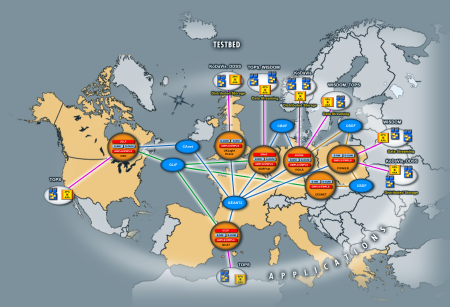About
A new generation of scientific applications is emerging that couples scientific instruments, data and high-end computing resources distributed on a global scale. Developed by collaborative, virtual communities, many of these applications have requirements such as determinism (e.g. guaranteed QoS), shared data spaces, large data transfers, that are often achievable only through dedicated optical bandwidth.
High capacity optical networking can satisfy bandwidth and latency requirements, but software tools and frameworks for end-to-end, on-demand provisioning of network services need to be developed in coordination with other resources (CPU and storage) and need to span multiple administrative and network technology domains.
In response to the above requirements, Phosphorus will address some of the key technical challenges to enable on-demand e2e network services across multiple domains. The Phosphorus network concept and test-bed will make applications aware of their complete Grid resources (computational and networking) environment and capabilities, and able to make dynamic, adaptive and optimized use of heterogeneous network infrastructures connecting various high-end resources.
 Figure 1 - The Phosphorus test-bed components and applications
Figure 1 - The Phosphorus test-bed components and applications
Phosphorus will enhance and demonstrate solutions that facilitate vertical and horizontal communication among applications middleware, existing Network Resource Provisioning Systems, and the proposed Grid-GMPLS Control Plane (figure 2).
The Phosphorus assessment will rely on experimental activities on a distributed test-bed interconnecting European and worldwide optical infrastructures. Specifically, the test-bed will involve European NRENs and national test-beds, as well as international resources (GÉANT2, Internet2, Canarie, Cross Border Dark Fibre infrastructures and GLIF virtual facility). A set of highly demanding applications will be adapted to prove the concept (figure 1).
Phosphorus will disseminate procedures, toolkits and middleware to the EU NRENs and their users, such as Supercomputing centres and the wider European and worldwide scientific users.
 Figure 2 - The layers of the Phosphorus architecture and development components
Figure 2 - The layers of the Phosphorus architecture and development components
